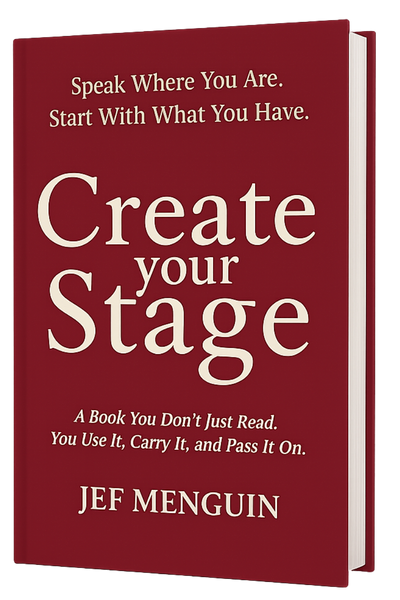Glossophobia is an intense fear of public speaking. However, not every flutter in your stomach before a speech is glossophobia. As a public speaking coach, I’ve seen many faces go pale at the thought of speaking in front of a crowd. But nervousness is often just a natural human reaction, not a clinical anxiety disorder.
In this article, we’re not delving into the depths of glossophobia. That’s a job for therapists and psychologists. What we are going to tackle are the common fears and misconceptions about public speaking that hold so many back. These aren’t deep-rooted phobias; they’re challenges that can be overcome with the right approach and mindset.
Think of public speaking as a skill, like riding a bike or cooking your favorite meal. It’s not about curing an inherent fear but learning and practicing until what once seemed daunting becomes second nature.
By the end of this journey, you’ll see that the fear you thought was a giant monster might just be a shadow on the wall.
Fears in Public Speaking
What exactly sparks fear in public speaking? It’s crucial to understand the roots of our anxiety to effectively address it. Let’s start by unraveling the true nature of glossophobia and separating fact from fiction.
Definition and Misconceptions about Glossophobia
Glossophobia is often tossed around as a catch-all term for any fear related to public speaking. But in reality, it’s much more specific. Glossophobia is an anxiety disorder, marked not just by nervousness or butterflies but by intense, overwhelming fear and physical symptoms that can include shaking, sweating, and even panic attacks. It’s not just about feeling a bit anxious; it’s about experiencing a level of fear that significantly disrupts your life.
However, there’s a common misconception that anyone who dreads public speaking must have glossophobia. Not true. Feeling nervous or even fearful about public speaking is a nearly universal experience. It’s a natural response to being in the spotlight, where you’re vulnerable to judgment and criticism. But this doesn’t mean you have a disorder; it means you’re human.
Another myth is that if you have glossophobia, you’re doomed to forever fear public speaking. Again, not true. Like many anxiety disorders, glossophobia can be managed and treated with the help of professionals.
For those without glossophobia, understanding this distinction is empowering. It means that the discomfort you feel about public speaking isn’t an insurmountable, clinical issue but a common challenge that can be tackled with practice and the right strategies.
By differentiating between normal public speaking nerves and glossophobia, we can approach our fears with a clearer perspective and set the stage for effective strategies to conquer them.
The aim is not to eliminate fear entirely but to understand and manage it, turning a daunting task into an opportunity for growth and confidence building.
Common Fears vs. Glossophobia
When we talk about fear of public speaking, it’s essential to distinguish between common fears and glossophobia.
Common Fears:
- Fear of Judgment: This is perhaps the most widespread fear. It’s the worry about what others will think of you, your ideas, or your performance.
- Fear of Mistakes: Many fear they’ll say something wrong or forget their lines, leading to embarrassment.
- Fear of Negative Evaluation: This involves anxiety over receiving criticism or not meeting expectations, whether those of the audience or self-imposed.
These fears are normal and often occur even in experienced speakers. They’re usually situational, tied to specific speaking events, and vary in intensity.
Glossophobia:
- Severe Physical Reactions: Symptoms like intense shaking, sweating, or even panic attacks that go beyond normal nervousness.
- Extreme Avoidance Behaviors: People with glossophobia often go to great lengths to avoid speaking situations, which can impact their personal and professional lives.
- Consistent and Pervasive Fear: Unlike common fears, which can fluctuate, glossophobia presents a consistent, intense fear of public speaking across situations.
Psychological Basis of Public Speaking Anxiety
The fear of public speaking is closely linked to the fear of social judgment and rejection, both deeply ingrained in human nature. Humans are social beings. The fear of being ostracized or negatively judged by the group is a significant survival concern.
Another aspect is the spotlight effect. This is our tendency to overestimate how much others notice and judge our actions and appearance. In public speaking, this can manifest as an exaggerated sense of scrutiny and judgment from the audience.
Perfectionism also plays a role. Many people fear public speaking because they feel they must deliver a flawless performance. This unrealistic expectation can amplify anxiety and fear of failure.
Finally, there’s the element of unfamiliarity. For many, public speaking is not a routine activity. The lack of familiarity can create uncertainty, fueling anxiety.
Understanding these psychological underpinnings can help in developing strategies to manage and overcome public speaking anxiety. It’s not about eradicating fear but recognizing its source and learning to navigate it effectively.
Demystifying Public Speaking Myths
Let’s bust some myths. Public speaking isn’t a natural gift bestowed upon a lucky few. It’s a skill, and like any skill, it’s built on practice, understanding, and a bit of myth-busting. Here are three big myths that need to be shown the door:
Myth 1: Only Inexperienced Speakers Feel Nervous
Wrong. Even the most seasoned speakers get butterflies. The difference? They’ve learned to channel that energy positively. Nervousness is a sign you care, and caring is good. The key is to harness that feeling, not eliminate it.
Myth 2: Perfection is the Key to Successful Public Speaking
Nope. Striving for perfection in public speaking is like chasing a mirage. It’s unattainable and unnecessary. Great speakers aren’t perfect; they’re authentic, relatable, and engaging. They make mistakes, but they roll with them. So, aim for connection, not perfection.
Myth 3: Audience Hostility or Indifference
Here’s the thing: most audiences want you to succeed. They’re rooting for you, not waiting for you to slip up. The belief that audiences are hostile or indifferent is often just a projection of our insecurities. In reality, they’re there to listen, learn, and engage.
By knocking down these myths, we open up a world of possibility. Public speaking isn’t a domain for the flawless or the fearless. It’s a playground for the passionate, the prepared, and the persistent. And that, my friend, could very well be you.
12 Practical Strategies to Overcome Fear of Public Speaking
Now, let’s roll up our sleeves and get practical. This section is all about tangible strategies to turn your public speaking fear into fuel for success. It’s about doing the work, making small changes, and seeing big results. Let’s start with the cornerstone of all great public speaking: knowing your material.
Know Your Material
Knowing your material isn’t just about memorizing your speech. It’s about diving deep into your topic, understanding it inside and out. It’s having that confidence that comes from true mastery.
When you know your stuff, your confidence naturally rises. You’re no longer just reciting words; you’re sharing knowledge. This mastery reduces the fear of making mistakes because you’re grounded in what you know. It also allows you to be more flexible and adaptive during your speech, as you’re not just clinging to a memorized script.
Start by researching your topic thoroughly. Go beyond your speech. Learn more than you need to. Then, practice. But don’t just repeat your speech like a parrot. Engage with the material. Teach it to someone else. Discuss it. Make it a part of you.
When you stand up to speak, you won’t just be delivering a speech; you’ll be sharing a part of your world. And that’s a game-changer.
Build Confidence Through Rehearsal
Rehearsal isn’t just repetition; it’s purposeful improvement. It’s about rehearsing your speech, refining it, and getting comfortable with your content and delivery. This isn’t about rote memorization but developing a familiarity that breeds confidence.
Consistent practice diminishes the unknowns. The more you practice, the more you iron out kinks, familiarize yourself with your material, and anticipate questions or reactions. This familiarity breeds a sense of control and ease, which is essential in reducing anxiety. It’s like a muscle; the more you exercise it, the stronger it becomes.
Start with a schedule. Dedicate time each day to practice your speech. Use different methods: in front of a mirror, recording yourself, or in front of a trusted friend or family member. Each time, focus on one aspect to improve, whether it’s your tone, body language, or pacing.
As you progress, simulate the speaking environment – stand up, use a microphone if possible, and practice in front of small groups. Remember, effective practice is about quality, not just quantity.
Visualize Success
Visualization is a powerful tool. It involves mentally picturing yourself giving a successful, confident speech. Imagine the setting, the audience’s positive reactions, and the feeling of satisfaction from delivering your message effectively.
Visualization taps into your brain’s ability to prepare for and simulate real-life experiences. By visualizing success, you’re training your mind to expect positive outcomes, reducing fear and anxiety. It’s like a rehearsal within your mind, building a path towards the confident delivery of your speech.
Start incorporating visualization into your preparation routine. Find a quiet place, close your eyes, and picture the entire process of giving your speech, from walking onto the stage to the final applause. Focus on the details – the sound of your voice, the engagement of the audience, and the feeling of confidence.
Do this regularly, especially right before going to bed or as part of your morning routine. Over time, these positive visualizations will help shift your mindset from one of anxiety to one of anticipation and confidence.
Tailor Your Message
Understanding your audience. Know who they are, what interests them, and what they expect to gain from your speech. It’s about tailoring your message to resonate with their values, experiences, and level of understanding.
When you align your speech with your audience’s interests and needs, you create a connection. This connection not only makes your speech more effective but also reduces your anxiety. Knowing that your message is tailored to your audience gives you a sense of purpose and direction, making your speech more than just words – it’s a meaningful conversation.
Start by researching your audience. Who are they? What are their backgrounds? What might they be interested in or need to know? Use this information to shape your content, examples, and even your humor. If possible, interact with your audience before your speech – this can be as simple as mingling before the event or asking for input via surveys. The more you know about your audience, the more you can speak directly to them, turning a monologue into a dialogue.
Build Confidence with Smaller Audiences
Start small. Begin your public speaking journey with smaller, less intimidating audiences. This could be a group of friends, a local club, or a small workshop. The idea is to gradually increase the size of your audience as your confidence grows.
Speaking to a smaller group reduces the pressure and allows you to develop your skills in a more controlled, supportive environment. It’s a stepping-stone approach. Each positive experience builds your confidence, making the idea of speaking to larger groups less daunting. You get the chance to refine your message, receive feedback, and adjust your style in a low-stakes setting.
Look for opportunities to speak in front of small groups. This could be at a local Toastmasters club, a community meeting, or even within your workplace. Focus on the experience, not just the content of your speech. Pay attention to how you feel, how you engage with the audience, and what works well.
Gradually, as you feel more comfortable, seek opportunities to speak to larger groups. Remember, it’s not about jumping into the deep end right away; it’s about wading in gradually, building your skills and confidence step by step.
Use Body Language Effectively
Body language in public speaking includes your posture, gestures, facial expressions, and eye contact. It’s about how you physically present yourself and your message. Effective body language can enhance your speech and make your words more impactful.
Your audience doesn’t just listen with their ears; they “listen” with their eyes too. Good body language conveys confidence, engages the audience, and reinforces your message. Poor body language, on the other hand, can distract or even contradict what you’re saying. By being mindful of your non-verbal cues, you can create a more powerful and persuasive speech.
Begin by becoming aware of your body language. Record yourself giving a speech and observe your movements. Are you standing confidently? Are your gestures adding to your message or distracting from it? Practice making eye contact, even if it’s just with a few people in the audience. Work on gestures that feel natural and complement your points.
Remember, body language is an extension of your message, not a separate entity. Integrating strong, confident body language with your words will make your overall presentation more effective and engaging.
Master Breathing Techniques
Breathing techniques involve using controlled breathing to calm your nerves and manage the physical symptoms of anxiety, such as a rapid heartbeat or shaking hands. These techniques can range from deep abdominal breathing to more structured exercises like the 4-7-8 method.
When you’re nervous, your breathing tends to become quick and shallow, which can increase feelings of anxiety and stress. By consciously controlling your breathing, you can trigger your body’s natural relaxation response. This not only helps you feel calmer but also improves your voice control and presence.
Start by practicing deep breathing exercises daily. You can do this anywhere – at your desk, during a walk, or before going to bed. Focus on breathing deeply from your diaphragm, filling your lungs completely, and then exhaling slowly.
Before your speech, take a few minutes to engage in these breathing exercises to center yourself. Remember, this isn’t just about calming your nerves; it’s about preparing your mind and body to perform at their best.
With consistent practice, these breathing techniques can become a reliable tool to manage public speaking anxiety.
Learn from Experience
Actively ask for and listen to input about your speeches. This can come from your audience, peers, or a mentor. Feedback is essential for understanding how your message is received and what areas you can improve.
It provides you with a perspective outside of your own. You learn what works, what doesn’t, and how others perceive your delivery and content. Constructive feedback helps you grow and refine your skills. It’s not about criticism; it’s about gaining insights that you can’t see from your own vantage point.
After every speaking opportunity, ask for feedback. This could be informal, like a conversation with audience members, or more structured, like a feedback form. Listen openly, without defensiveness. Remember, every piece of feedback is a gift, even if it’s hard to hear. Use this information to adjust and improve.
Keep a feedback journal, noting down comments and your reflections on them. Over time, you’ll see patterns and areas for improvement, helping you evolve into a more effective speaker.
Embrace feedback as a valuable tool in your journey to becoming a confident public speaker.
Accept and Learn from Mistakes
Embrace imperfections. Accept that mistakes and hiccups are a natural part of public speaking. It’s about acknowledging that no speech will be perfect and that this is completely okay.
When you accept that imperfections are inevitable, you reduce the pressure to deliver a flawless performance. This shift in perspective can significantly decrease anxiety and fear. Realizing that mistakes are opportunities for learning and growth fosters resilience and a more relaxed approach to speaking.
Start by reflecting on past experiences where things didn’t go as planned. What did you learn from these instances? How can you apply these lessons in the future? During your next speech, if you stumble or forget a line, don’t panic. Take a moment, breathe, and continue.
After the speech, instead of dwelling on what went wrong, focus on what went right and how you can improve next time. Embrace a growth mindset: view each speaking opportunity, not as a test of your abilities, but as a chance to learn and improve.
This approach will not only make public speaking more enjoyable but also more rewarding in the long run.
Engage with Your Audience
Engaging with your audience means creating a two-way interaction during your speech. It involves looking for ways to connect with your listeners, whether through eye contact, asking questions, or responding to their cues and reactions.
A speech is not just about delivering information; it’s about creating an experience. When you engage with your audience, you make them a part of your presentation. This interaction makes your speech more memorable and impactful. Plus, seeing your audience respond positively can boost your confidence and reduce your nervousness.
Plan ways to interact with your audience. This could be as simple as asking rhetorical questions, encouraging a show of hands, or pausing for reactions.
During your speech, make eye contact with different people in the audience, as this creates a sense of connection and engagement. Be attentive to their reactions and adjust your delivery accordingly.
Remember, public speaking is a dialogue, not a monologue. By actively engaging your audience, you transform your speech into a dynamic and interactive experience.
Use of Visual Aids to Enhance Your Message
Using visual aids involves incorporating elements like slides, charts, or props into your speech. These aids serve to complement and reinforce your message, making it more engaging and understandable for your audience.
Visual aids do more than just break up the monotony of a speech; they can enhance understanding, provide emphasis, and make your message more memorable. Visual aids can also serve as cues, helping you stay on track during your presentation. They give your audience an alternative focus point, which can alleviate some of the pressure you might feel.
Start by identifying key points in your speech that could benefit from visual reinforcement. Create slides or gather materials that are simple, clear, and relevant to your message.
Practice with these aids to ensure they integrate seamlessly into your presentation.
Remember, visual aids should support your speech, not overshadow it. Use them to enhance your message, not as a crutch. With thoughtful and well-integrated visual aids, your speech can become more dynamic and engaging for your audience.
Seek Professional Coaching
Seeking professional coaching means getting guidance and feedback from someone experienced in public speaking. This could be a coach, a mentor, or a seasoned speaker. Their role is to provide you with personalized advice, techniques, and feedback to improve your public speaking skills.
A professional coach brings a wealth of experience and can offer insights that you might not be able to see on your own. They can identify areas for improvement, provide encouragement, and help you navigate challenges. A coach also offers accountability, keeping you on track with your goals and helping you push through barriers.
Start by researching and identifying a coach or mentor who aligns with your speaking style and goals. This might involve joining a public speaking group like Toastmasters, attending workshops, or seeking one-on-one coaching. Be open to feedback and willing to try new techniques.
Remember, the role of a coach is not to change your unique style but to refine and enhance it. With the support and guidance of a mentor, you can accelerate your growth and gain confidence more quickly and effectively.
Begin your journey.
We’ve tackled myths, embraced practical strategies, and unlocked the doors to building confidence and skill. Remember, public speaking isn’t a talent reserved for a select few; it’s a craft that anyone can learn and excel in with the right approach and mindset.
We’ve explored everything from the importance of knowing your material, practicing effectively, and visualizing success, to understanding your audience, starting small, and using body language effectively. We’ve learned the value of breathing techniques, welcoming feedback, embracing imperfections, engaging with our audience, utilizing visual aids, and the transformative role of professional coaching.
As you apply these strategies, remember that the goal is not to eliminate fear completely but to manage and harness it. It’s about transforming nervous energy into enthusiasm, uncertainty into opportunity, and fear into fuel for growth.
Public speaking is a journey, not a destination. Each step you take, each speech you give, is a step towards becoming a more confident, capable, and impactful speaker. Embrace the process, enjoy the learning, and celebrate your progress. The world is waiting to hear your voice, your ideas, and your stories. So go ahead, step up to the podium, and let your journey of confident public speaking begin.






